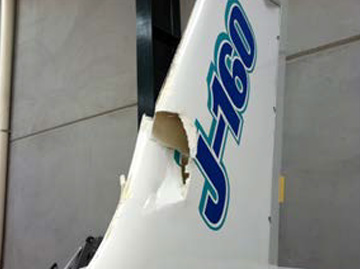
A collision between two aircraft has shown the dangers that exist at Australia’s many non-controlled aerodromes.
On 10 November 2013, a flight instructor and a student pilot were flying circuits in a Cessna 152 at Tyabb aerodrome, Victoria. Deciding to conduct a practice glide approach and a touch-and-go landing, the pilot commenced the approach from closer to the runway than for a normal circuit. As they commenced a continuous turn towards runway 17, he broadcast his intentions.
At the same time, the pilot of a Jabiru J160 with one passenger on board was at the holding point, preparing to take off from the same runway. He heard the Cessna’s broadcast, but when he looked for it in the normal circuit position, he could not see it. He assumed that it was sufficiently distant that he would have time to leave the holding area and take off. He broadcast that he was lining up and rolling on runway 17, and then he commenced the take-off run.
This accident has demonstrated the need for pilots to maintain good communication and a good lookout, especially when operating at non-controlled aerodromes, and doubly so when conducting non-standard or modified circuits.
In fact, the Cessna was much closer than he thought, coming in behind him on a high, close final approach. The pilot of the Cessna had seen the Jabiru waiting at the holding point, and broadcast that he was coming into the runway. He assumed that the Jabiru would continue to hold until the Cessna had landed.
Neither pilot, however, heard the other’s broadcast and they may have transmitted their calls simultaneously.
The student pilot of the Cessna continued the glide approach, aiming to touch down about halfway along the runway. The Jabiru, however, had commenced take-off and, as his aircraft became airborne, the pilot saw the underside of the Cessna appear from above and fill the windscreen. The Cessna appeared to be overtaking the Jabiru very slowly and still descending.
The two aircraft collided, with the elevator trim tab of the Cessna contacting the fin of the Jabiru. The pilot of the Jabiru would later recall that the wheels of the Cessna appeared to be either side of his cockpit, with the front wheel just clear of the Jabiru’s propeller blades.
The pilot of the Jabiru forced the aircraft onto the ground and it skidded along the runway.
The pilot of the Cessna heard a loud bang behind him, but did not see the Jabiru. He took control of the aircraft from the student and commenced a go-around.
The Jabiru was substantially damaged, and the Cessna sustained damage to the right elevator and trim tab. No one was injured.
This accident has demonstrated the need for pilots to maintain good communication and a good lookout, especially when operating at non-controlled aerodromes, and doubly so when conducting non-standard or modified circuits.
The issue of safety around non-controlled aerodromes is one of the ATSB’s top safety concerns. ATSB research has found that, between 2003 and 2008, there were 709 airspace-related events at, or in the vicinity of non-towered aerodromes. This included 60 serious incidents and six accidents (mid-air and ground collisions). Most of the 60 serious incidents were near mid-air collisions.
The ATSB’s SafetyWatch initiative and report on safety in the vicinity of non-towered aerodromes, provides useful advice and strategies for pilots.
Read the final report: Mid-air collision involving a Cessna 152, VH-TNV and a Jabiru J160, 19-4430, Tyabb Airport, Victoria, on 10 November 2013


